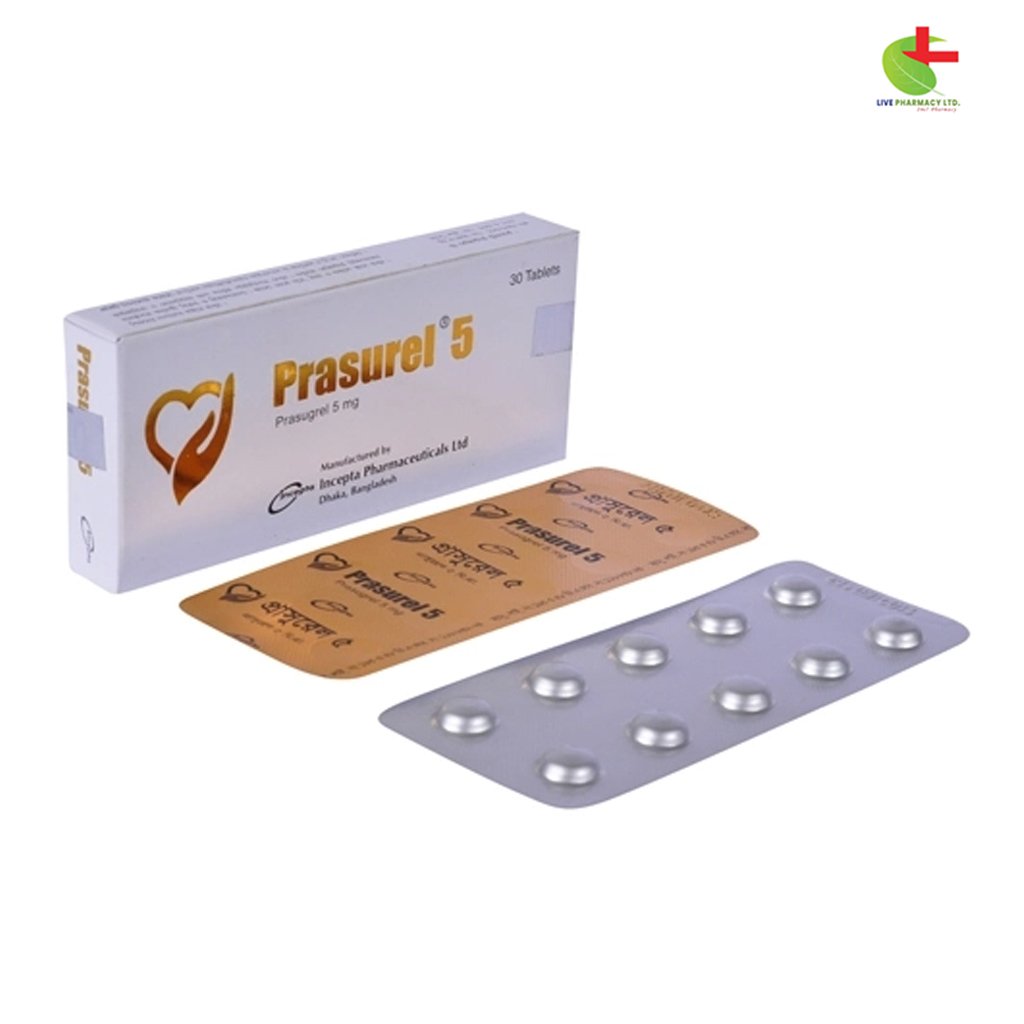Prasurel 5
120.00৳ Strip
- Prasurel is an anti-platelet medication that reduces thrombotic cardiovascular events, including stent thrombosis.
- Indicated for patients with acute coronary syndrome undergoing percutaneous coronary intervention.
- Inhibits platelet activation by irreversibly binding to P2Y12 receptors.
- Administered as a 60 mg loading dose followed by a daily maintenance dose.
- Consult a healthcare professional for proper use and monitoring.
 Brand
Brand
|
Incepta Pharmaceuticals Ltd |
|---|---|
 Generics
Generics
|
Prasugrel Hydrochloride |
 Type
Type
|
Tablet |
Indications
Prasurel is prescribed to lower the incidence of thrombotic cardiovascular (CV) events, including stent thrombosis, in patients experiencing acute coronary syndrome (ACS) who will undergo percutaneous coronary intervention (PCI). This includes:
- Patients with unstable angina (UA) or non-ST-elevation myocardial infarction (NSTEMI).
- Patients with ST-elevation myocardial infarction (STEMI) undergoing primary or delayed PCI.
Always use medication as directed by a registered healthcare professional.
Pharmacology
Prasugrel functions as a potent inhibitor of platelet activation and aggregation by irreversibly binding its active metabolite to the P2Y12 subtype of ADP receptors on platelets.
Dosage & Administration
Initiate treatment with a single oral loading dose of 60 mg. Follow up with a daily maintenance dose of 10 mg, which can be taken with or without food. For patients weighing less than 60 kg, consider a reduced dose of 5 mg daily. Patients should also be prescribed daily aspirin (75 mg to 325 mg).
Always use medication as directed by a registered healthcare professional.
Interactions
- The concurrent use of Prasurel and warfarin may elevate the risk of bleeding.
- Combining Prasurel with NSAIDs (used chronically) can also increase bleeding risk.
- Prasurel can be safely used alongside cytochrome P450 enzyme inducers or inhibitors, as well as with aspirin, heparin, GPIIb/IIIa inhibitors, statins, and medications that increase gastric pH, such as proton pump inhibitors and H2 blockers.
Contraindications
- Active pathological bleeding, such as peptic ulcers or intracranial hemorrhage.
- History of transient ischemic attack or stroke.
Side Effects
Common side effects include:
- Bleeding
- Thrombotic thrombocytopenic purpura
- Other potential effects: headache, back pain, shortness of breath, nausea, hypertension, bradycardia, rash, etc.
Pregnancy & Lactation
While adequate studies on Prasugrel use in pregnant women are lacking, animal studies (at doses up to 30 times the recommended human exposure) showed no evidence of fetal harm. However, animal responses do not always predict human outcomes.
It is unclear if Prasugrel is excreted in human milk. Therefore, it should be used during breastfeeding only if the potential benefits to the mother outweigh the risks to the infant.
Precautions & Warnings
- Patients undergoing CABG may experience increased bleeding risk while on Prasurel.
- Stopping Prasurel prematurely raises the likelihood of stent thrombosis, myocardial infarction (MI), and mortality.
Use in Special Populations
- Pediatric Use: The safety and efficacy of Prasugrel in children have not been established.
- Geriatric Use: In patients over 75 years old, there is a higher risk (1.0%) of fatal bleeding compared to those receiving Clopidogrel (0.1%).
- Renal Impairment: No dosage adjustment is necessary for those with renal issues; however, experience in end-stage renal disease is limited.
- Hepatic Impairment: No dosage adjustment is needed for mild to moderate hepatic impairment.
Overdose Effects
In animal studies, a lethal dose of 2000 mg/kg was noted. Platelet transfusion may be effective in restoring clotting ability, and the active metabolite of Prasugrel is unlikely to be eliminated through dialysis.
Therapeutic Class
Anti-platelet agents
Storage Conditions
Store in a dry area, protected from light and heat. Keep out of reach of children.













Reviews
There are no reviews yet.